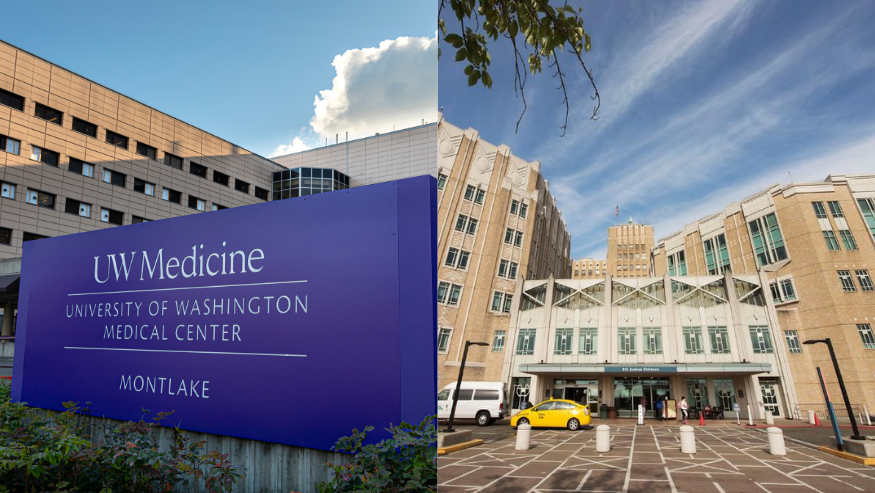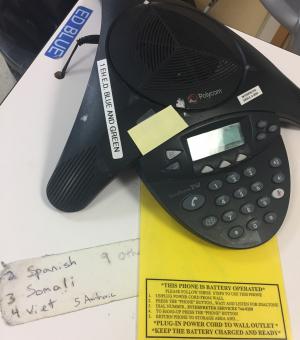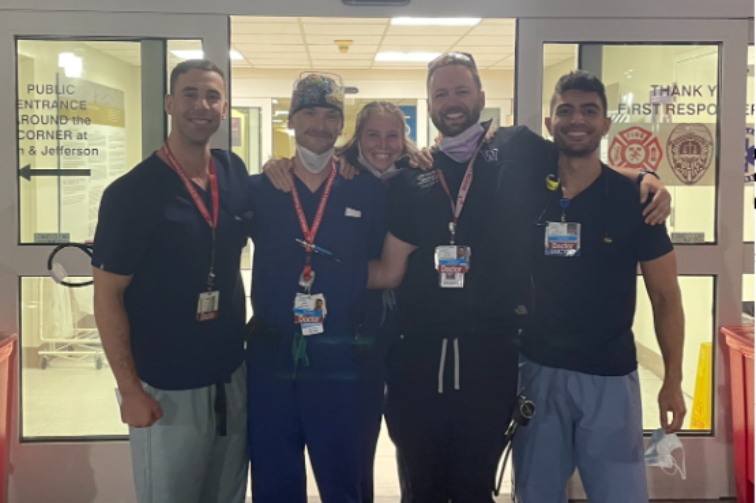Diversity of Hospital Experiences
Two medical centers serve as “home”: Harborview Medical Center (a level 1 adult and pediatric trauma and burn center/county hospital) and the University of Washington Medical Center (a large tertiary care center). The remainder of resident training time is divided between Valley Medical Center (a community hospital) and Seattle Children’s Hospital (a large pediatric hospital). The variety of facilities strengthens training, challenges residents to be adaptable, and prepares them to care for patients in any setting.

Right: Harborview Medical Center
Residents also have the opportunity to rotate at one of our rural partnership sites, at either St. Luke's Wood River Medical Center in Ketchum, Idaho, or Peace Island Medical Center in Friday Harbor, Washington.
As Dr. Ryan Keay, Medical Director of the Providence Regional Medical Center in Everett notes:
"Here at North Sound Emergency Medicine we serve the busiest emergency department in Washington, at Providence Regional Medical Center Everett. Since the UW/HMC Emergency Medicine residency’s inception, we’ve found the quality of doctors trained there to be exceptional and a good fit for our busy, high acuity community practice. They are well-rounded, compassionate and hard-working physicians. The residents we’ve hired have all become valuable members of our practice."
Trauma Doc and Medic One Doc Roles
Given the high volume and acuity of patients, Harborview Medical Center’s Emergency Department (HMC ED) is divided into primary medical and trauma areas. Beginning in the PGY-2 year, residents take on a unique role as they transition from the intern position to providing online medical control for Seattle’s paramedics.
On the medical side, residents serve as the “Medic One Doc,” caring for the most critically ill patients, including complex transfers from across the five-state WWAMI region (Washington, Wyoming, Alaska, Montana, and Idaho).
On the trauma side, residents step into the role of “Trauma Doc,” where they manage the trauma wing, lead codes, supervise and teach interns and medical students, and care for the sickest trauma patients.
Both the Medic One and Trauma Docs remain closely connected to Seattle and King County’s emergency response system. These roles are designed to challenge residents and give them early, hands-on experience in running a busy emergency department
Our Faculty
The Department of Emergency Medicine is fortunate to have recruited the very best to join our already exceptional faculty. With training backgrounds from across the country, our faculty bring a wide range of practice styles that enrich the residency experience—and make for dynamic, engaging teaching conferences.
Faculty members pursue diverse academic and clinical interests and are eager to involve residents in their projects. Most importantly, they are deeply committed to resident education and are enjoyable, supportive, and inspiring colleagues to work alongside.
Mentorship & Career Development Opportunities
Hear it directly from our outstanding faculty!
Our faculty have come together to showcase the wide range of mentorship, training, and educational opportunities available within the UW Emergency Medicine Residency Program. Whether your interests lie in Population Health, Emergency Medical Services, or other areas, you will find robust mentorship and career development opportunities designed to support residents with diverse goals and passions.
Diversity of Patients

According to the 2020 U.S. Census, King County’s population (which includes Seattle) is 21.7% Asian, 10.5% Hispanic/Latino, 7.4% Black, and 5.6% multiracial.
Nearly one-quarter of King County residents (24%) are foreign-born, and 28.9% speak a language other than English at home. At Harborview, the most common languages spoken by Emergency Department patients, aside from English, are Spanish and Somali.
The Census Bureau has also identified Seattle’s Rainier Valley as the most diverse neighborhood in the country, with fewer than 25% of residents identifying as white and the remainder representing Hispanic, African American, and Asian communities.
"One of the things that initially attracted me to Harborview was the mission to serve the most vulnerable patients. In Emergency Medicine, we are on the front line of patient care, and we get to experience--and influence-- the intersection between social issues and health. At Harborview, I get to work with like-minded individuals who are passionate about providing care for the underserved, and I leave work feeling like I've made a difference." -- Elizabeth Harmon, MD, Class of 2020
Integrated Pediatric Exposure
Approximately 16% of patients seen in the emergency departments at Harborview Medical Center (HMC) and the University of Washington Medical Center (UWMC) are children under the age of 17. To ensure residents maintain strong pediatric skills, the residents will rotate at Seattle Children's Hospital throughout their training to provide a comprehensive, longitudinal pediatric emergency medicine experience. All SCH faculty are fellowship-trained in pediatric emergency medicine.
During the intern year, residents complete a dedicated one-month rotation in the SCH Emergency Department, gaining concentrated training in pediatric emergency care. Beginning in the PGY-2 year, SCH ED shifts are integrated alongside shifts at HMC and UWMC, ensuring continued exposure throughout residency. In the PGY-3 year, residents also rotate through the Pediatric Intensive Care Unit (PICU), managing critically ill children in collaboration with pediatric ICU attendings, fellows, and residents.
In addition to training at Seattle Children’s Hospital, residents further broaden their pediatric experience through community-based emergency care at Valley Medical Center.
Transfer Center for the WWAMI Region
Mauled by a bear in Alaska? Caught in an avalanche in the Cascade Mountains? Paragliding accident in Montana? Rollover motor vehicle collision in Seattle? You’ll be treated at Harborview.
From routine emergencies to extraordinary cases, Harborview sees it all. As the only Level I Trauma Center serving Washington, Alaska, Montana, and Idaho, Harborview provides comprehensive care for an unmatched variety of trauma patients across the WWAMI region and locally in Seattle.
ICU Experience
Critical care training is a cornerstone of the Emergency Medicine residency. Over the four-year curriculum, residents gain extensive ICU experience across multiple specialized units:
- Trauma/Surgical ICU – 4 weeks
- Medical ICU – 8 weeks
- Pediatric ICU – 4 weeks
- Burns/BICU – 4 weeks
- Cardiac Care ICU – 4 weeks
The ICUs at Harborview Medical Center (HMC) and the University of Washington Medical Center (UWMC) care for the most critically ill patients in the WWAMI region (Washington, Wyoming, Alaska, Montana, and Idaho), providing residents with exposure to complex, high-acuity cases and advanced critical care management.
Serving the Underserved
Harborview is a high-volume county hospital that serves a diverse patient population, including immigrants, incarcerated individuals, people with mental illness, and those experiencing homelessness. A central mission of Harborview is to provide high-quality care to these vulnerable and underserved communities.
For residents, this offers a unique training environment that goes beyond typical emergency medicine exposure. Working with these populations, residents develop advanced skills in cultural competence, resource navigation, and complex medical and social problem-solving. This experience prepares graduates to deliver compassionate, high-level care to all patients, including those facing significant social and health disparities.
About Us - Residents
Our residents come from a variety of backgrounds and medical schools from all over the US and the globe. Our residents' interests may be varied, backgrounds diverse, and personalities eclectic, but there are two things that join them together:
- They love emergency medicine
- They love spending time with each other
There is a strong sense of camaraderie in this program; our residents are a great group of fun, interesting, talented people (and clinicians!).




